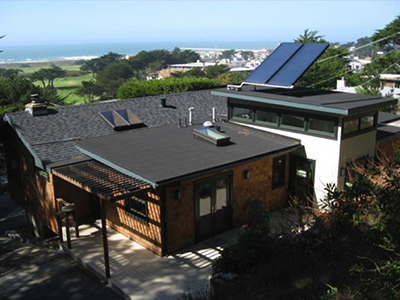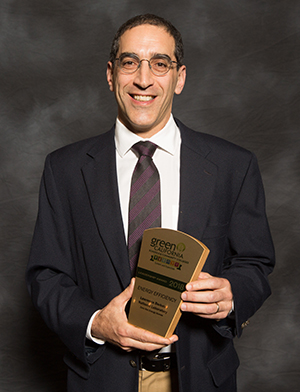Honors for Zero Net Energy Buildings Work


Lawrence Berkeley National Laboratory was recently honored with a prestigious Green Leadership Award at the 12th Annual Green California Summit in Sacramento.
The Lab's Energy Technologies Area (ETA) was highlighted for innovative breakthroughs in the energy efficiency category for research aimed at helping California meet its zero net energy (ZNE) building goals, while ensuring adequate indoor air quality and ventilation.
 A ZNE, or net zero building, is a building with zero net energy consumption, meaning the total amount of energy used by the building on an annual basis is roughly equal to the amount of renewable energy created on the site, or by renewable energy sources elsewhere. ZNE buildings consequently contribute less overall greenhouse gas to the atmosphere than similar non-ZNE buildings.
A ZNE, or net zero building, is a building with zero net energy consumption, meaning the total amount of energy used by the building on an annual basis is roughly equal to the amount of renewable energy created on the site, or by renewable energy sources elsewhere. ZNE buildings consequently contribute less overall greenhouse gas to the atmosphere than similar non-ZNE buildings.
The awards, held in early April, highlight successful state and local government sustainability projects implemented over the previous year. ETA has contributed broadly to making ZNE a reality, and is conducting analyses to demonstrate the cost-effectiveness of ZNE homes and also looking at the economics over time for multiple regions of the state, for example, as the industry scales up.
Brett Singer (pictured above) accepted the award at the Summit on behalf of Berkeley Lab.
Rengie Chan (pictured below), research scientist in the Indoor Group, also made a presentation at the event, in conjunction with UC Davis, on the subject: "Ensuring Proper Installation and Commissioning of HVAC Systems for Energy Efficiency and Indoor Air Quality.
Innovative Contributions
There have been many innovative and impactful contributions to achieving ZNE in California, specifically supporting the state's target to ensure all new residential construction is ZNE by 2020 and potentially boosting ZNE homes from 7000 units in 2017 to over 150,000 units in 2020. Research includes:
- Conducting analyses to demonstrate cost-effectiveness
- Developing new technologies (e.g. smart ventilation, lighting, windows, etc)
- Investigating low-cost approaches for sealed and insulated attics
- Identifying market-ready technologies
- Illuminating opportunities for energy savings (e.g. builder-installed loads)
- Analyzing potential indoor air quality impacts
- Informing energy-efficient solutions
With funding from the California Energy Commission, the Lab is providing detailed cost-effectiveness modeling of all-electric ZNE homes and mixed-fuel ZNE homes. Additionally, the Lab is examining the cost-effectiveness, benefits and feasibility of emerging implementation options such as community solar, storage, and demand response/demand shifting. The analysis integrates building costs, the costs of building energy efficiency packages, installed equipment life-cycle costs and infrastructure costs (natural gas pipeline and electricity distribution system).
Meanwhile, lab researchers are assessing cost-effectiveness over time for multiple regions of the state, for example, as the ZNE industry scales up and under various policy and energy cost assumptions.